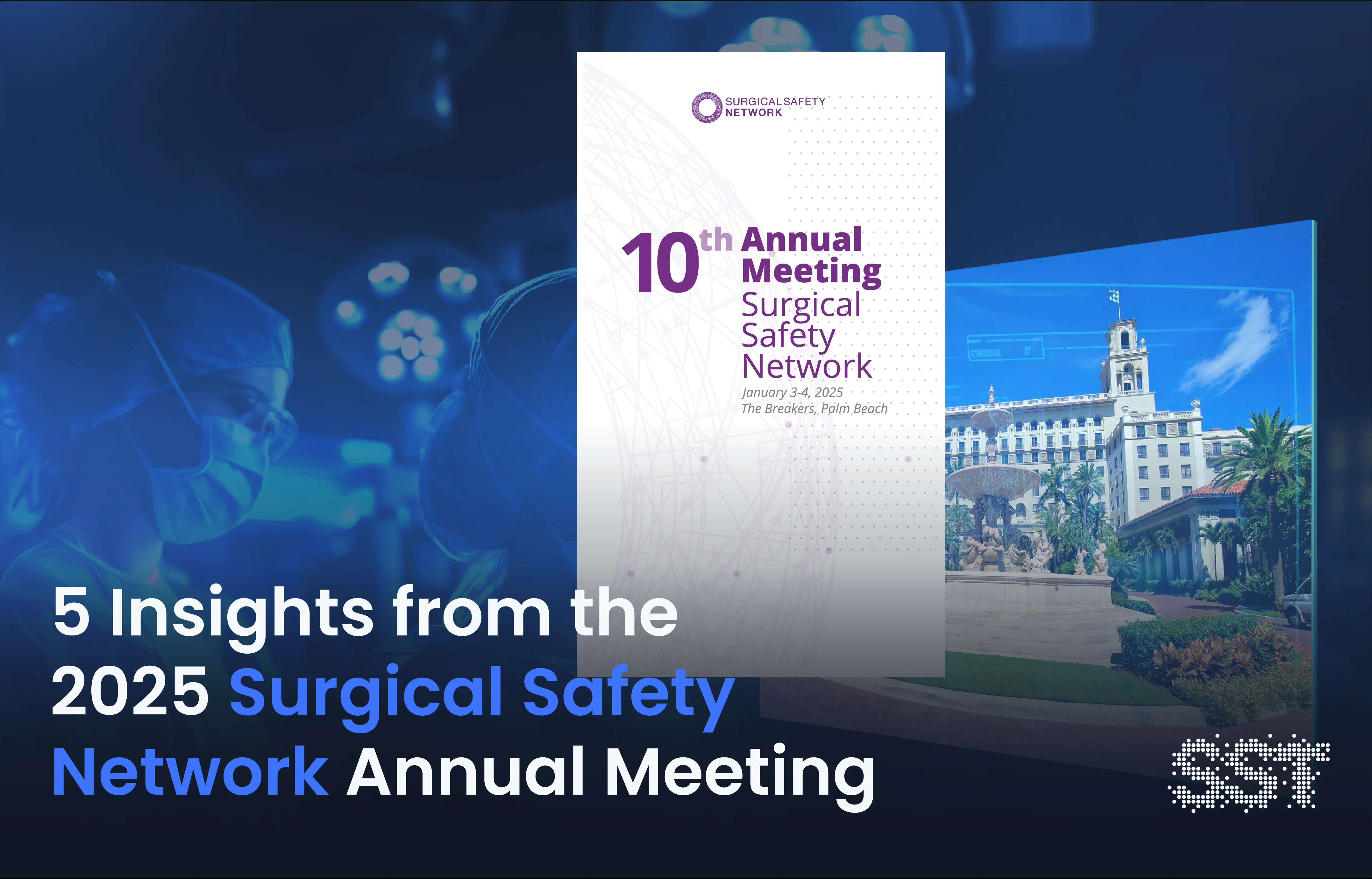PATIENT SAFETY
Prioritizing Patient Safety Through Effective KPIs and Risk Management Strategies
Patient safety is paramount as provider organizations balance rising costs with increasing scrutiny over quality of care.
Mar 28, 2025
Surgical Safety Technologies
In today's healthcare landscape, patient safety is paramount as provider organizations balance rising costs with increasing scrutiny over quality of care and an inherent responsibility to ensure the well-being of the patients they serve. Implementing Key Performance Indicators (KPIs) and risk management strategies has long been the standard approach to improving patient outcomes. However, traditional methods often fall short¹ in effectively identifying and mitigating risks, leading to persistent gaps in patient safety.
The Limitations of Traditional KPIs and Risk Management Approaches
While KPIs such as medication error rates, hospital-acquired infection rates, and patient falls provide valuable insights, they have inherent limitations that can impact the effectiveness of safety measures and increase the potential for adverse events and malpractice claims:
Retrospective Focus: Traditional KPIs often rely on historical data, meaning that by the time an issue is identified, harm may have already occurred. This retrospective approach limits the ability to implement proactive interventions. For example, injury-based metrics may not effectively discriminate preventable incidents, leading to misdirected interventions and missed opportunities to prevent harm.
Lack of Granularity: These metrics often fail to capture the underlying causes of adverse events, making it challenging to implement targeted improvements. Without understanding the specific factors contributing to incidents, healthcare organizations may struggle to develop effective prevention strategies. This lack of detailed insight can result in persistent safety issues and an increased risk of malpractice claims.
Subjectivity in Reporting: Many patient safety incidents rely on self-reporting, which can introduce bias and lead to underreporting of critical events. This subjectivity hampers the accuracy of safety data, making it difficult to assess the true extent of risks and address them effectively. Consequently, unreported or misreported incidents can escalate into more severe problems, increasing the likelihood of patient harm and subsequent legal action.
Siloed Data: Many hospitals operate with fragmented data systems,² making it difficult to integrate and analyze information across departments. This fragmentation can lead to incomplete assessments of patient safety risks and hinder the development of comprehensive risk management strategies. Without a holistic view of data, organizations may overlook systemic issues, resulting in increased vulnerability to adverse events and potential claims.
The Role of Artificial Intelligence (AI) in Enhancing Patient Safety
Artificial Intelligence (AI) offers promising avenues to address the limitations of traditional patient safety and risk management strategies. AI transforms patient safety by enabling real-time risk identification, event analysis, and proactive risk mitigation.
For example, one of the most significant advantages of AI is its ability to capture near misses—incidents that could have led to harm but were averted—without relying on extensive retrospective analysis. AI provides an always-on safety net to detect deviations from best practices before they result in harm.
Beyond real-time monitoring, AI is also revolutionizing risk management by helping in the analysis of closed claims trends. Traditionally, hospitals review settled malpractice cases in a siloed, postmortem fashion, struggling to extract actionable insights. AI-driven, ambient technology can identify recurring issues, procedural failures, and latent risks that might otherwise go unnoticed. This moves risk management from a reactive process to a real-time one, allowing healthcare organizations to implement safety interventions before adverse events ever occur.³ The power of this proactive approach cannot be overstated - if a hospital can prevent a claim before it even happens, it both protects patients and mitigates the financial and reputational damage associated with preventable medical errors. Never events, which are catastrophic, costly, and legally indefensible, become far less frequent when AI is leveraged effectively.
AI is also being used in simulation-based training to refine clinical practices and prevent harm. impact a patient. The results speak for themselves: not only does patient safety improve, but the culture around learning and accountability is strengthened.
Yet perhaps the most compelling testament to AI-driven ambient technology is the response from doctors and nurses who use it. Many healthcare professionals report that once they’ve experienced the benefits, they would never go back to working without it. This sentiment raises an important ethical consideration - would you want a loved one to undergo a procedure without the added protection of continuous AI analysis? Technology has given healthcare an unprecedented ability to mitigate harm before it happens, and as adoption grows, the expectation will shift from whether to use it—to why it isn't already standard practice.
Join the Patient Safety Conversation
Leveraging AI to improve patient safety is a key topic at the annual Surgical Safety Network⁴ meeting and was discussed in depth during its 2025 event.⁵
For example, during the 10th annual meeting, one academic medical center demonstrated the impact of automated outlier detection in predicting critical outcomes. Monitoring factors like hypoxia and surgical complexity, researchers were able to predict:
Surgical site infections
Return-to-OR rates
Hospital length of stay
Mortality risks
The meeting also discussed patient safety resources, such as collaborative knowledge networks, to help advance approaches to mitigating harm. As we look ahead, readers are encouraged to stay tuned for information regarding the 2026 Surgical Safety Network meeting, which will continue to focus on advancing patient safety initiatives.
Conclusion
Prioritizing patient safety requires moving beyond traditional KPIs and risk management strategies. By leveraging AI-driven insights and predictive analytics, healthcare organizations can proactively identify risks, implement targeted interventions, and ultimately improve patient outcomes. As technology continues to evolve, embracing AI will be a critical step in ensuring the highest standards of patient safety.
SST is dedicated to supporting healthcare organizations in their pursuit of excellence in patient safety. Our Black Box Platform™ is designed to help identify trends, discover risks, and change behaviors to prevent unintended harm. Our commitment to quality and safety is further endorsed by MedPro Group,⁶ a leading provider of healthcare liability insurance, underscoring our dedication to delivering reliable and effective technology for the betterment of patient care.
Download our fact sheet to learn more about leveraging AI-driven ambient technology to mitigate risk and improve patient safety.⁷
Recommended Reading
Scanlon, M.C., Karsh, B.T., & Saran, K.A. (2008). Risk-Based Patient Safety Metrics. Agency for Healthcare Research and Quality. https://www.ncbi.nlm.nih.gov/books/NBK43628/pdf/Bookshelf_NBK43628.pdf
Bokar, V. (2007). Risk and Quality Management Partnering for Patient Safety. American Society for Healthcare Risk Management. https://www.ashrm.org/sites/default/files/ashrm/Monograph.07RiskQuality.pdf
Al Abbas, A.I., Meier, J., Daniel, W., et., al. (2024). Impact of team performance on the surgical safety checklist on patient outcomes: An operating room black box analysis. Surg Endosc;38, 5613–5622. https://www.doi.org/10.1007/s00464-024-11064-7
Surgical Safety Technologies. Surgical Safety Network. (2025). https://www.surgicalsafety.com/company/surgical-safety-network
Surgical Safety Technologies. (2025, February 3). Transforming Healthcare: 5 Insights from the 2025 Surgical Safety Network Annual Meeting [blog]. https://www.surgicalsafety.com/blog/transforming-healthcare-5-surgical-safety-network-insights
Surgical Safety Technologies. (2025, January 14). MedPro Group Endorses Surgical Safety Technologies’ OR Black Box® as Ground-breaking Technology to Improve Surgical Quality and Safety [press release]. https://www.surgicalsafety.com/company/news/medpro-group-endorses-surgical-safety-technologies-or-black-box-as-ground-breaking-technology-to-improve-surgical-quality-and-safety
Surgical Safety Technologies. (2025). AI in Healthcare: Mitigating Legal and Data Security Risks [fact sheet]. (2025). www.surgicalsafety.com/resources/ai-in-healthcare-mitigating-legal-and-data-security-risks







